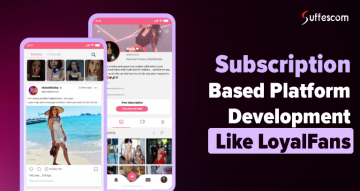How to Create a Decentralized Social Media App in 2025?

From Facebook to X (Twitter), centralized social media has revolutionized communication—yet exposed users to data misuse, censorship, and lack of transparency. In 2025, decentralized blockchain-based social media apps are disrupting this model by returning control to users.
These apps offer transparency, data ownership, and censorship resistance through blockchain technology. But how do you create a decentralized social network app that stands out in the Web3 ecosystem?
In this guide, you'll learn the exact steps to build a blockchain-powered social media platform, explore its benefits, features, monetization potential, and how to launch it successfully.
Why Decentralized Social Media Is the Future
Traditional platforms like Facebook, Instagram, and Twitter rely on centralized databases, which collect user data, impose content restrictions, and profit from user-generated content without equitable rewards.
- Blockchain-based social media apps solve this by using:
- Decentralized architecture for tamper-proof data
- Smart contracts for transparent rules and rewards
- Crypto tokens to incentivize creators
- User-owned data with customizable permissions
Blockchain enables censorship resistance, data privacy, and community governance, making it ideal for next-gen social platforms.
Create a Decentralized Blockchain based Social Media Apps
Decentralized social media networks are social platforms that are based on the blockchain or we can say web3 social media software and it specifically secure user's data from censorship or hackers.
9 Steps to Build a Blockchain-Based Social Media App
In order to build a decentralized social network app with blockchain technology, you should know about the Blockchain development process. Here is a simple step-to-step guide to creating a blockchain on social media platform
Step 1: Work on Concept/Idea
Communication with old and new friends and the possibility of news about them are just some features of Facebook. Using LinkedIn, you may connect with other professionals in your field. Using YouTube, you may post endless videos to the network and share them with anybody. Instagram, a photo-centric version of the same concept, was launched in 2010.
In order to build a blockchain-based decentralized network, you should first identify a unique idea within your grasp. This concept should be well-liked by a significant number of people. It should also encourage them to engage in multiple ways such as communication, such as viewing videos, reading texts, leaving comments, and giving likes.
Step 2: Select a Name & Domain Name
Once you have a concept, you may begin the process of naming your social network and registering your domain name. Ideally, your project's name should be a single or a combination of two words that capture the essence of your endeavor while being simple to say and recall. Examples include the iPhone, YouTube, Twitter, and search engines.
Step 3: Do Market Research
It's not just a matter of writing code and distributing the app to consumers when creating a social media app. Its success can be attributed to its ability to do thorough market research. Starting a company requires a comprehensive analysis of the competition, especially in terms of winning methods.
An in-depth understanding of the market allows companies to create a unique product that covers the value gap of existing apps. Rather than being just another app on the market, a new app must have a unique selling proposition
Step 4: Identify Target Audience
Getting feedback from the people who will use your social networking app is critical to the success of your startup. The ideal audience's preferences and habits are considered during the process.
Startups should make one-on-one conversations with their customers instead of relying on intuitions. This gives the founders a better understanding of the issues and enables them to work on a solution. The ability to communicate with current users early on aids in developing a ready audience for the app.
Step 5: Define Functions & Features
The next step to create your own decentralized social network app is deciding the functionality and features of the platform. Features, security, design, and code quality are the most common, although some of them are unique:
What Should be Decentralized?
In other words, who is responsible for deciding where the platform should go, how much advertising should be shown, how much censorship should be implemented, and so on. Also, who creates the User Agreement and has the authority to alter it.
How to Store and Manage User Data?
When creating a decentralized social network that doesn't gather personal data at the technological level, you can develop a system where the user chooses whether or not to collect this data and how it will be used: gift, sell, change, or delete.
How Should You Distribute the Earnings by the Social Network?
The site may collect all the revenue in a single pool. Then divide it among users based on their contributions. Alternatively, each user can earn money by running ads on their page and not having to go via an intermediary.
Step 6: Build an Attractive Design
At this point, businesses should put all the information gathered to good use. The quality of the user experience will determine the success or failure of new social networking apps. The app must be tailored to the user's needs by an organization with a thorough understanding of their expectations.
As far as social media apps are concerned, less is more. It would be best if you ensured that the app was visually appealing and functional. Potential subscribers will be turned off by an unorganized and confusing design. While this is a good strategy, the organization should target a group of people who could benefit from the service. The goal is to create a digital ecosystem where everyone who uses the app is satisfied.
Step 7: Begin the Development & Testing
To begin development, the design must be given to the programmers once it has been finalized. Determine your development strategy in order to build an optimal decentralized social network app. It is possible to take one of two ways to develop a product:
Starting from scratch is the best option if you want to build a truly decentralized social network. It takes a lot of effort and money, but the payoff is that you can set yourself apart from the competition and come up with something unique.
Launching a social network based on an existing platform is possible. It is tailored to your needs to launch a decentralized social network. It will minimize the development time and costs.
You can begin coding as soon as you've accomplished all the preliminary work and have a clear vision for your decentralized social network. As a result, you'll need a development team that works both in-state and outsourced. The first choice allows the user more control, while the second provides a guarantee of high quality.
Depending on the project's complexity and approach, direct coding can take anything from a few days to a few months. You should also devote a third of this time to testing the platform. This is critical since no team can develop error-free code. It is only via testing that the flaws may be identified and corrected. It can lead to an improved platform in terms of scalability, responsiveness, and security.
Step 8: Refine the Social Network App
There is a lot more to establishing a successful product than launching a social network app. The next stage is to get feedback from users. Observing user input is an excellent way to get a sense of what the app needs and what it does well.
Businesses must constantly iterate in response to customer feedback in order to ensure that the next release is in line with users' habits and requirements. At this point, entrepreneurs must rely on analytics to make more precise predictions about trends and behaviors. When developing an app, it's essential to keep in mind that improvisation is a constant process.
Step 9: Promotional Strategy
It would be best if you had a lot of people to make your social network a success. Promoting it through different marketing channels is the best way to get them.
If you want to do this, you'll need a marketing strategy that includes the following:
Targeted Ads
Advertising tailored to a specific demographic, previous search history, purchases, or behavior is known as targeted advertising.
There are two types of characteristics: demographic (based on race, gender, age, education, income, and occupation) or psychographics (based on personality qualities).
Influencer Marketing
Influencer marketing is promoting a product or service on social media by enlisting the help of people and organizations with a high level of expertise or social influence.
It is possible to show support for a product or service through explicit advertising and simply using it.
Content Marketing
Creating and disseminating information online (videos, articles, blogs, and social media posts) that does not explicitly promote a brand but aims to increase interest in its products or services is the goal of content marketing.
Organic Ads
Using search engines and social networks to direct people to the information they need is known as organic advertising. Search engine optimization (SEO), local search engine optimization (LSI), and other content optimization techniques are frequently employed in these situations.
Various other methods can be used to market a product or service, like games, contests, and more.
Ready to Build Your Decentralized Social Media App?
TLet’s bring your idea to life. Suffescom Solutions is a leading blockchain development company with expertise in building secure, scalable Web3 social platforms.
Key Features of Decentralised Social Network App
Confidentiality
Decentralized social networks allow users to set their own rules for how their data is used, preventing and allowing for the transfer, sale, and monetization of their data. This will be the result of blockchain technology and smart contracts. Since this software is open source, anyone may verify its dependability and sincerity.
User Rights & Freedom
Reading the terms of service for Facebook, YouTube, or Twitter will show that the average user has virtually no rights in these highly centralized social media platforms. You can't ask for more in terms of quality, dependability, or security because services are delivered as it is. All shared issues (development and management), as well as the private preferences of each user, are addressed in decentralized systems.
No Censorship
Many popular social media accounts, such as Facebook, Instagram, Twitter, and YouTube, have been accused of breaking site censorship policies. This is most apparent in countries where freedom of speech is a problem.
Reward System
These social networks have been hugely successful thanks to their users, who post content for free and promote them on their own time. But the platform doesn't share the profits with the content creators. As far as I know, no, they don't. Then why do they, if they are not charging anything at all?
This strategy is unfair in that people work alone and others earn millions. Different models are employed in decentralised social networks. It allows the creators of the content to profit from every view, like, remark, and other active activity of the audience. Users, not Facebook or YouTube, will benefit financially from any advertising.
Want to Create Your Own Decentralised Social Network App?
A successful launch of a social media app involves a combination of strategy, feedback, and improvisation. The app's success hinges on each step of creating a decentralized social network app.
While traditional social media is growing in popularity due to the enhanced marketing and entertainment it provides its users, it is also declining in use. Data and privacy breaches have become a growing issue with these platforms, which is why many people are concerned.
With its decentralized and distributed networks, blockchain social media may provide an answer to these problems. They provide users more control over their data, among other things. You can consult a decentralized social network development company to build your own platform. For that, Suffescom Solutions might be the right choice. They are the leaders in the Blockchain dApp Development industry with proven experience in building social media apps.
FAQs
1. What is a decentralized social media app?
A decentralized social media app is built on blockchain, allowing users to own their data and content without interference from centralized authorities.
2. How is blockchain used in social media?
Blockchain enables decentralized data storage, transparent governance, and token-based rewards for content creators in social platforms.
3. Can I monetize a decentralized social media app?
Yes. With built-in crypto rewards, ad revenue sharing, and NFTs, users and app owners can generate revenue in various ways.
4. What are examples of decentralized social media platforms?
Lens Protocol, Mastodon, and Steemit are popular examples using blockchain or federated structures to decentralize control.
5. How much does it cost to build a decentralized social media app?
Depending on features, blockchain choice, and UI complexity, development costs range from $50,000 to $200,000+. White-label options may lower this.








